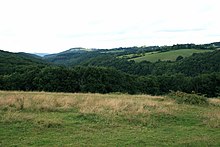This article has multiple issues. Please help improve it or discuss these issues on the talk page. (Learn how and when to remove these messages)
|

The Glozel artifacts are a collection of over 3,000 artifacts, including forged clay tablets, sculptures and vases, some of which were inscribed, discovered from 1924 to 1930 in the vicinity of French hamlet of Glozel.[1]
Promoted by their discoverers as proof of an advanced prehistoric civilization, the finds initiated a series of claims and counterclaims. The objects were all initially dismissed as a hoax by professional archaelogists.[2] Later research confirmed that some of the items date back to the Iron Age,[3] but it was not before a 1995 study ordered by the French Ministry for Culture that the "prehistoric civilization" thesis was rebutted and the vast majority of the finds dated to the Middle Ages, with significant presence of alterations and forgeries.[4]
- ^ Glozel (46°02′N 3°36′E / 46.033°N 3.600°E) is part of the commune of Ferrières-sur-Sichon in the Allier department, some 17 km from Vichy in central France.
- ^ Vayson de Pradenne, A. (1933). "The Glozel Forgeries". Antiquity. 4 (14): 201–222. doi:10.1017/S0003598X00004518. ISSN 0003-598X.
- ^ Cite error: The named reference
McKerrell1974was invoked but never defined (see the help page). - ^ Jean-Pierre, Daugas; J-P, Démoule; Jean, Guilaine; Didier, Miallier; Pierre, Pétrequin; Jean-Claude, Poursat (1995). "Résumé des recherches effectuées à Glozel entre 1983 et 1990, sous l'égide du ministère de la culture". Revue archéologique du Centre de la France (in French). 34 (1): 251–259. Retrieved 4 May 2018.